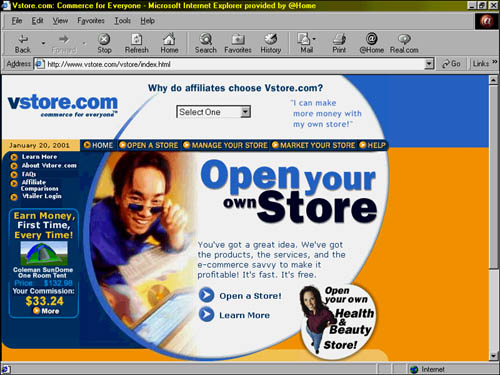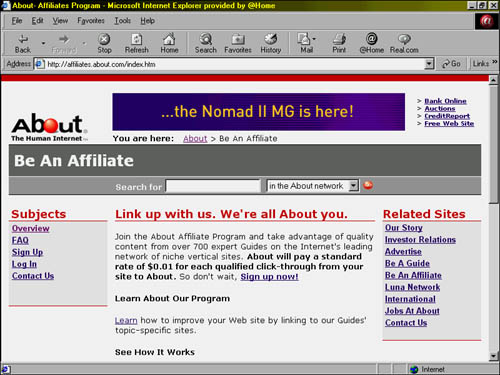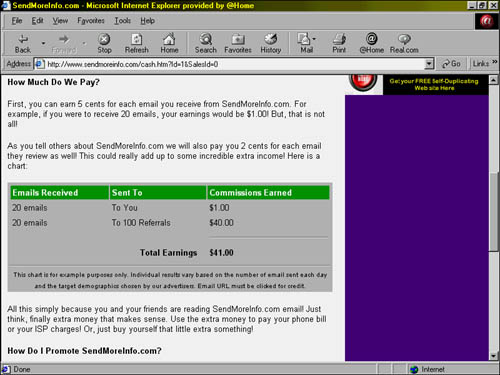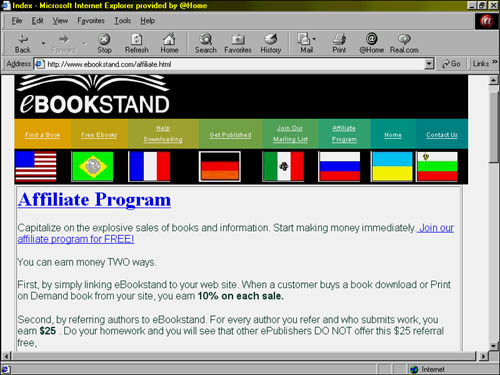Payment Plans—How Much to Pay
You’ll find that affiliate payment plans are all over the map because several forces are at work. For most companies, it’s their gross profit margins that dictate the payouts to their affiliates. That’s why commissions are relatively low on commodity items, such as books, CDs, videos, PCs, and consumer electronics. There’s not much there to pay affiliates.
For companies that sell downloadable products, such as software and books, the margins are a lot higher. In these cases a merchant can pay a much higher pay out. Sometimes even this doesn’t happen. Merchants tend to be stingy with their affiliates and forget that they are a true business partner and should be compensated at the level of their best portal partners. If you have the margin to pay affiliates higher—do it. Treat your affiliate partners the same way you would any strategic business partner. Check your competition. Know your own margins and customer values. Think about all the ways and combinations of ways to pay your affiliates, and offer a way for them to earn revenue from the lifetime value of the customers they send you.
Do
|
| DON’T short change your affiliates. If you have the margins in your product to pay higher commissions, do it. It will pay off in affiliate loyalty and barriers to competition down the road. |
Short changing such an important sales channel will only hurt you in the future.
Affiliate marketing doesn’t always work for high-ticket items such as automobiles or homes because people don’t buy enough of them to make the affiliate model work. A straight commission program selling homes or cars would earn payments that were few and far between for an affiliate partner. A better payment program would be a pay-per-lead plan, where a car dealer or real estate company would pay the affiliate for each qualified lead that he or she sends to the agent’s site. A good example is Autoweb.com (www.autoweb.com)(see Figure 10.1). It pays affiliates for every customer they bring to Autoweb’s Web site who lists a vehicle to sell or completes a purchase request for a new or pre-owned vehicle.
Figure 10.1. Autoweb will pay affiliates for every customer they bring who lists a vehicle to sell or completes a purchase request for a new or pre-owned vehicle at Autoweb.

If you want to pay only for sales that are made, then a pay-per-sale plan is best for your program. If you want to build a prospect list of potential customers or perhaps collect demographic information on consumers to use later on for marketing purposes, then a pay-per-lead plan would be the way to go. Or perhaps the type of business you have would benefit best from paying a one-time bounty on any customers referred to you by your affiliates. Then again, you might consider offering an affiliate program to Web site partners that gives them the opportunity to earn additional revenue from a two-tiered or residual-income program.
So choosing the right type of affiliate model is important to the success of your affiliate marketing program—and there are several to choose from:
Pay-per-Sale Programs
Customer Acquisition Programs
Pay-per-Lead Programs
Pay-per-Click Programs
Two-Tier Programs
Residual Earnings Programs
Affiliate marketing is very flexible and comes in all shapes and sizes. You will also find that the affiliate models are sometimes used in combination (see Table 10.1). When you’re trying to decide what type of affiliate model to offer, it’s good to look at what models are currently being used on the Net and how they’re applied to selling actual products and services.
| Merchant | Per Sale | Per Customer | Per Lead | Per Click | Two-Tier | Residual Earnings |
|---|---|---|---|---|---|---|
| Amazon | YES | |||||
| ClubMom | YES | |||||
| EToys | YES | |||||
| PayTrust | YES | |||||
| Flowers Fast | YES | YES | ||||
| TechnoSurf | YES | YES | ||||
| eSportStuff | YES | YES | ||||
| Virtualis | YES | YES |
Let’s take a closer look at some typical affiliate programs and what they offer their affiliates.
Pay-per-Sale—Commission Based/Revenue Sharing Programs
One of the oldest forms of affiliate marketing is the pay-per-sale plan. In this model, the affiliate is paid a predetermined percentage for each sale generated by his or her site visitors. Although this seems simple on the surface, not all commission-based programs are the same. The most common offer a flat commission rate on each sale no matter how much an affiliate sells. Other pay-per-sale models offer a sliding scale of commissions—the more an affiliate sells, the higher the commission rate. This gives the affiliate an incentive to more vigorously promote the merchant’s product or service. Your commission rates can be higher for high-margin goods, such as books or software, that can be downloaded by or e-mailed to customers.
Forrester Research interviewed 50 retailers with online affiliate programs that were in place for at least three months. According to this report, most sites pay an average 9.2% commission rate to affiliates, but to recruit the best affiliate sites, some affiliate programs pay 20% or more.
Here are some examples of the pay-per-sale model.
The granddaddy of all pay-per-sale affiliate programs is Amazon.com (www.amazon.com/exec/obidos/subst/associates/join/associates.html/). Affiliates that join its program earn commissions of up to 15%. Amazon carries hundreds of thousands of book titles on almost every conceivable subject, paying 15% on over 400,000 select titles and 5% on more than 1.1 million additional book titles, CDs, and other products. Amazon does not require its affiliates to meet sales quotas to receive a commission. It pays quarterly commissions on every eligible sale regardless of how much the affiliate sells.
Do
|
| DO consider using a pay-per-sale model. This model is the most direct and most profitable example of a pay-for-performance affiliate marketing program. |
The Sports Authority sells equipment, footwear, and apparel for indoor and outdoor activities. Through its affiliate program (www.thesportsauthority.com/affiliate/index.jsp), Web sites receive all the tools they need to quickly and easily build their own online sporting goods store and start making money from their site. The program pays up to a 10% commission to the affiliate on each sale. The Sports Authority has partnered with Commission Junction—an affiliate solution provider—to provide affiliates with dependable third-party tracking, customized reporting, and monthly commission checks with a $25 minimum pay out per check.
Two other popular products that sell well on the Net are posters and prints. AllPosters.com (www.allposters.com/affiliates/affiliatesstart.asp) (see Figure 10.2) is a leading retailer of posters and prints, with over 50,000 items including an extensive selection from movies, music, sports, and fine art. It pays its affiliates a 15%–20% commission on each sale. Affiliates can choose from over 50,000 images to place on their site that link to Allposters.com. That’s what’s unique about Allposters’ program. Instead of supplying a generalized banner link offering posters for sale, affiliates can actually place individual images of posters that can be purchased with a link directly to that offer.
Figure 10.2. Allposters.com’s affiliates program is unique. Affiliates can place individual images of posters that can be purchased with a link directly to that offer.

Standing products, such as books, CDs, toys, sports equipment, and posters, are not the only things that can be sold through an affiliate program. Take iPrint for example. iPrint (www.iprint.com) is an online printing company that does professional print jobs for its customers. It will take online orders for business cards, stationary, signs, and banners and ship them to the customer. Affiliates earn a 5% commission on every paid order placed and shipped through the link on their site. In addition, the affiliate also makes money on every reorder from its site.
More and more, the traditional click-and-bye affiliate model is being replaced with the click-and-buy one. Over the last few years, a new type of pay-per-sale affiliate program has emerged. This program does not sell products themselves, but sells the products of other online merchants. The program gives affiliates the ability to set up an actual store on their site and earn commissions on every product they sell. These programs have improved upon the traditional pay-per-sale affiliate model by allowing the affiliate to keep the visitors on their site while they shop and buy.
vstore (www.vstore.com) (see Figure 10.3) is one example. vstore’s model allows the affiliate to keep the visitor on their site after a purchase is made. With vstore, affiliates can sell products from over 130 distributors. vstore offers affiliates a choice of themes and categories to feature in their store, such as a NASCAR, Elvis, or an Irish store. Current commissions range from 2%–25%, depending on the type of products the affiliate sells.
Figure 10.3. vstore’s model allows the affiliate to keep the visitor on their site after a purchase is made.

Then there’s Mercata (www.mercata.com/). Just about all pay-per-sale affiliate programs work on a fixed price model. Not so with Mercata. With its e-commerce system, the more people who buy a product the lower the price will go. It is offering to let Web sites to participate in this new way of selling on the net through its affiliate program. Affiliates earn a 5% commission on sales generated through a link from its Web site. Through Mercata, affiliates can sell personal electronics, home and kitchen, baby, lawn and garden, home office products, appliances, jewelry, tools, and other merchandise categories.
Finally, even intangibles can be sold through a pay-per-sale affiliate program. 180096hotel.com (www.180096hotel.com/html/hrnaffiliatelee.html) is a large hotel-reservations network that sells 50% of all non-airline system hotel reservations over the Internet. It features hotels in 27 major destinations worldwide. Using its affiliate program, an affiliate can build her own hotel booking area on her site with its own look and feel. The affiliate is paid a 5% commission on all hotel rooms booked on her site. With the average sale of a premium hotel room going for $350, the average commission per sale earned by an affiliate is $17.50.
Customer Acquisition Programs—Bounty Programs
Different from the pay-per-sale programs are the customer acquisition programs or bounty programs. Whereas affiliates in the pay-per-sale programs get paid each time a customer buys from their site, the customer acquisition program only pays once—upon the acquisition of the customer. In other words, the affiliate site is paid a fee for each new customer referred to the merchant who sets up an account. The customer must be a new, unique visitor and must purchase at least one product or service. Normally, any sales made by the customer later do not earn a commission for the affiliate.
Do
|
| DO consider paying a bounty for each customer instead of paying a commission on a sale to the affiliate if your sales cycle is long. Many products are not an impulse buy regardless of the sales pitch made by a good affiliate. Paying a bounty to the affiliate if the lead he sent previously buys is a fair way to compensate an affiliate for his work. |
Many products and services lend themselves to this type of program, more so than the pay-per-sale model. Here are some good examples:
With eToys (www.etoys.com/html/affiliate_home.shtml), affiliates can offer toys from one of the biggest toy stores on the Net. eToys will pay an affiliate $10 for every new customer she sends to its site. The eToys Storefront is the recommended feature for affiliates. This Storefront has a number of different links to many areas within the eToys site as well as the eToys popular quick search.
1st American Card (www.1stamericancardservice.com/FindersFee.html) is a company that offers credit card accounts for merchants who want to accept credit cards on their site.
Affiliates who direct qualified merchants to 1st American Card earn from $25.00–$450.00 per approved merchant.
Teknosurf AdWave (reports.advertising.com/webmaster/signup.jsp) offers Web site owners a way to generate revenues from their site with advertising. Affiliates can have sponsors, such as Hotmail, Amazon, Ebay, and Disney, sponsoring their site and paying the affiliate for every visitor they send to Teknosurf. It pays $5 for every Webmaster an affiliate refers who joins and $2 when he or she refer someone who joins.
InnovioOffice (www.innovio.com/affiliate.html), a small-business, e-commerce, Web-hosting, e-mail, and Internet access solution provider, pays affiliates a bounty of $50 when a prospective customer clicks the link on an affiliate’s site, signs up for InnovioOffice, and maintains the account for 32 days. Affiliates can make up to an additional $40 depending on which InnovioOffice service the affiliate’s referral chooses.
Internet.com Seminar Affiliate Program (www.internet.com/affiliates/) organizes seminars with events taking place in New York, San Francisco, and London. Events serve fields, such as affiliate programs and solutions, search engine promotion and strategies, and computer technology. By promoting internet.com seminars on its Web site, an affiliate can earn $50 per registration. Other bounty programs that pay per sign-ups are JFAX.COM (www.jfax.com/affiliate.html), B3 Productions (www.b3.com.au/affiliates.htm), and Vault.com (www.vault.com/vstore/pages/affiliate.cfm).
JFAX.COM (www.j2.com/about_j2/affiliates.asp) offers its customers a complete, unified messaging service—voice mails and faxes in their e-mail in-box—while affiliates earn a 50 cent bounty for every free Fax sign-up, along with an additional $3.00 should the subscriber upgrade to its premium service. B3 Productions hosts feature-rich personal Web sites. Affiliates that promote its program can earn a $50 or $100 bounty for each friend or colleague it signs up for a Web site.
Do
|
| DO consider a bounty or customer acquisition model if your product or service takes a long sales cycle. In this case, the affiliate site is paid a fee for each new customer referred to you who sets up an account |
Vault.com (vault.com/admin2/affiliate.jsp) (see Figure 10.4) provides career management and advancement tools to a professional audience. Affiliates that add Vault.com links to their Web site, e-mail, newsletter, or classified ads can earn $2.00 every time a customer referred to them signs up as a member of Vault.
Figure 10.4. Affiliates earn $2.00 every time a customer referred to them signs up as a member of Vault.

Pay-per-Lead—Lead Generation Programs
Some products do not sell well directly on the Internet. In this case, affiliate selling can help you acquire a number of pre-qualified leads and prospects that you can follow-up with and close later on. This model also works well to register people for services online. In the world of business there are customers and there are prospective customers. These prospective customers are sometimes called leads, and every successful business must attract a continuous number of them. There are a number of affiliate programs that do just that.
The pay-per-lead payment plan does not necessarily require that a customer lead actually purchase something. This model could include collecting e-mail addresses or filling out application forms, such as creating mailing lists and membership applications. A merchant will pay an affiliate simply for the chance to follow-up on a lead that may become an active customer.
Here are some examples of pay-per-lead programs.
ClubMom (http://www.clubmom.com/areas/corporate/affiliates.jhtml) (see Figure 10.5), the first free membership organization created exclusively to reward and celebrate Moms every day, pays $1 ($1.25 after 50 referrals) for each mom that registers for a free membership. Because the ClubMom site (www.clubmom.com) features original content, the articles, checklists, and other proprietary matter make great, high-conversion affiliate links.
Figure 10.5. ClubMom pays $1 ($1.25 after 50 referrals) for each mom who registers for a free membership.

Collegiate Funding Services (www.cfsloans.com/), a leading provider of repayment solutions to student loan borrowers, will pay affiliates $1.25 per lead.
PayTrust (affiliate.paytrust.com/aff/aff_home.htm), a payment solutions provider that allows subscribers to receive, pay, and organize all their bills online, will pay at least $20 for every customer an affiliate refers.
TigerQuote (www.tigerquote.com/) compares quotes from dozens of leading insurance providers—auto, home, life, and health—and helps its customers obtain the best possible plan and rate. It pays affiliates $2 per lead.
Another life insurance site with a pay-per-lead program is Termco.com (www.termco.com/), which sells term life insurance for consumers who want to compare term life rates online. Affiliates earn $5.00 per qualified lead for sending qualified insurance shoppers to the termco.com site.
Finally, there’s YAC (www.yac.com/). It pays affiliates $1.00 for each new subscriber that registers for a free personal YAC Number. A YAC Number is a new way of managing the phone calls, voice messages, and faxes people receive every day—free.
Pay-per-Click—Click-Through Programs
One of the simplest affiliate programs is the pay-per-click plan. Here the affiliate is paid a small fee for any and all traffic generated from the affiliate site whether or not customers purchase a product or perform an action on the merchant’s site. Although simple, it does have its problems. Pay-per-click programs are open to wholesale fraud and must be carefully tracked. There have been complaints of bait-and-switch tactics by merchants and wholesale click frauds by affiliates.
To help combat this problem, companies such as the ClickTrade Service (www.clicktrade.com), an affiliate network-reporting agency, have instituted a number of fraud protection measures to alleviate this problem. For example, among other measures, ClickTrade only records a lead or sale if it occurs on a Web page the advertiser has deemed as an allowed URL. It also states that affiliates will be credited (at most) only once every 24 hours for each unique surfer IP address. All the affiliate solution providers take measures to detect and prevent fraud. Still, because of their simplicity, pay-per click programs are very popular among merchants and affiliates alike. Here are some examples of the pay-per-click model:
NetSponsors.com (www.netsponsors.com/right_frame.htm) is an advertising network that pays 14 cents per click-through. It also pays $4 for every site an affiliate refers to its network.
About (affiliates.about.com/index.htm) (see Figure 10.6) pays $0.01 for each qualified click-through from an affiliate site to the content from more than 700 expert guides on About. The About program offers banners to its expert guides, as well as search banners for its entire site.
Figure 10.6. About pays $0.01 for each qualified click-through from an affiliate site to the content on About.

1 Nation Online (www.1nol.com/webmasters/index.asp) offers free Internet service just about anywhere in the United States. It will pay affiliates $.05 per click-through.
Affiliates that place EONS’ Network banners (eons.com/linkto_eons.htm) on their site earn $0.15 per unique click-through. EONS is a network of Web resources, including Web site creation tools, promotion tools, e-mail, and many other personal and Web-site resources.
Don’t
|
| DON’T immediately jump to the conclusion of fraud. Before approaching an affiliate about fraud, remember that some ISPs, including AOL, recycle IP addresses. This can spoof the appearance of fraudulent activity. |
BabyZone.com (www.babyzone.com/affiliate/), a company created and developed by parents, for parents, provides its site visitors with information, resources, and support on a wide range of parenting topics. It pays affiliates who link to its site $.05 per click-through. Flowers Fast (www.FlowersFast.com/getpaid.htm), an online flower shop, pays $.05 per click-through and a 10% commission if someone buys from its site.
Affiliates that join Private For Sale.com’s program (www.PrivateForSale.com/aff.html) can offer home searches directly from its site. It offers the Official Multiple Listing Service for the private home seller. Home sellers post listing online and upload photos. Affiliates receive $.01 per click-through and 10% per sale. It is a good program for Web sites that are in any way affiliated with real estate or home design and furnishings.
Two-Tier Programs
Another payment plan that has become very popular over the last few years is the two-tier model. These programs offer a referral fee when affiliates sign up other affiliates under them. A good example again is Teknosurf AdWave. It pays affiliates $5 for every Webmaster an affiliate refers who joins and $2 when they in turn refer someone else who joins.
Here are some examples:
Outsource 2000 (www.outsource2000.org/), a source for certified, home-based career resources, will pay 20% commission on first level and 10% on second level. Commissions come from memberships, products, and services.
HootingOwl.com (www.hootingowl.com/), a search engine that allows Web site owners to pay a small fee so their Web site appears as one of the top listings for a search word or phrase, pays a two-tier commission of 20% on the first tier and 10% on the second tier. Its affiliate program also pays lifetime commissions.
SendMoreInfo (www.sendmoreinfo.com/Page02.cfm) (see Figure 10.7—a program for individuals—pays its members for every e-mail message they and their second-level affiliates receive. The first-tier affiliate gets $.05 for every e-mail they receive, plus they get $.02 for every e-mail their referral receives or sends. Each member receives a personal Web site to send their friends and prospects to in order to sign up for the program.
Figure 10.7. SendMoreInfo affiliates get paid for every e-mail message they receive. And if one affiliate member tells others about SendMoreInfo.com, she will also get paid 2 cents for each e-mail she reviews as well.

With eSportStuff (www.esportstuff.com/affiliates.htm) first-tier affiliates earn a 10% commission every time someone referred by them purchases from eSportStuff. When an affiliate refers other affiliates he receives a 5% commission from his referrals. eSportStuff sells and auctions sports gear, trading cards, sports collectibles, and everything sports.
Residual Earnings Programs
Affiliate program commissions are not about how much anymore, but how long. So more and more affiliates are interested in getting paid for the lifetime value of the customers they send to you—one that provides residual earnings over the life of the customer. After all, the affiliate has worked hard to promote a program and deliver a paying customer to the merchant. For all her hard work, the affiliate would like to earn continued revenue from site visitors that have become steady customers of a merchant.
Here are some examples of residual earnings programs:
The AWeber (www.aweber.com/) Follow-Up Autoresponder tool earns affiliates a 20% recurring commission on each monthly service charge plus 10% from its second-tier affiliates.
DebtGuru.com (www.debtguru.com/affiliate_how.shtml), a debt-reduction program, pays affiliates $4 for first tier and $1 for second tier. Affiliates also earn $1 residual commission each month when a client makes his or her payment through the affiliate’s first-tier link and $.25 for payments made through the affiliates second-tier links.
Do
|
| DO offer to pay your affiliates for all future sales to a customer the affiliate sends to you using a residual earnings program. |
DomainsMatter.com (www.domainsmatter.com/earnings.html), a fully automated domain name registration site, offers affiliates a 20% commission plus 5% in residual earnings.
eBookstand.com (www.ebookstand.com/affiliate.html) (see Figure 10.8) pays affiliates 10% on the sales of its e-books plus, for every author the affiliate refers and who submits work, the affiliate earns $25 plus a residual 5% on all the sales of that author.
Figure 10.8. An affiliate of eBookstand.com earns 10% on the sales of its e-books plus $25 for every author the affiliate refers who submits work to e-books.

Infogenerator Systems (www.infogeneratorpro.com), a developer of automated e-mail marketing technology, pays out 30% commission on each sale made for the lifetime value of the customer. Finally, Virtualis (www.virtualisys.com/vr/radams45/vrp.html), a Web-hosting service, offers a recurring 10%–30% commission on monthly fees.
Capital One (www.capitalone.com) recognizes the entire customer value at day one, paying a one-time up-front payout of $25 of the lifetime value of the customer to the affiliate.
The OneandOnly.com Associate Network (www.oneandonlynetwork.com), the most widely-used matchmaking and romance site on the Internet, pays 15%–40% for every subscription. OneandOnly.com issues commission checks monthly with no minimum.
As you can see, a company can create an affiliate program for just about any product or service sold on the Net. All it takes is a little forethought and planning to choose the right affiliate payment plan to make your program a success.
